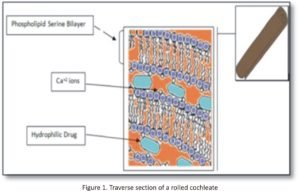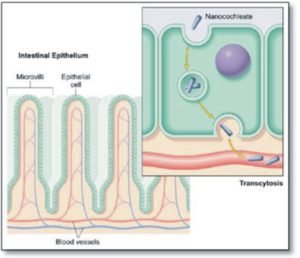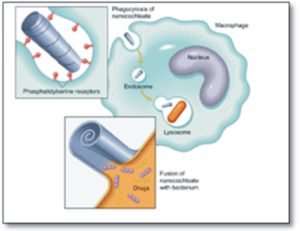By Komal R Nikam
Nanaocochleate represents a new technology for oral and systemic delivery of drugs. It is a novel lipid-based system is a unique technology platform suitable for the oral and systemic administration of a wide variety of molecules with important therapeutic biological activities, including drugs, genes, and vaccine antigens. Nanocochleate formulation technology is particularly applicable to macromolecules as well as small molecule drugs that are hydrophobic, positively charged, negatively charged and that possess poor oral bioavailability. Proof-of-principle studies for cochleate-mediated oral delivery of macromolecules as well as small molecule drugs is being carried out in appropriate animal models with well established, clinically important drugs, which currently can only be effectively delivered by injection.
Structure and function
Cochleate and nanocochleate are cigar like spiral rolls formed of negatively charged phospholipid bilayers, which are rolled up through the interaction with multivalent counter ions (Ca 2+ or Zn 2+ ) as bridging agents between the bilayers .

As a particulate system, cochleates possess unique properties like superior mechanical stability and better protection for encapsulated drugs compared with liposomes due to their solid matrix. Cochleates also maintain their phospholipid bilayer structures. These solid particles are so flexible that they can readily convert to liposomes by extracting the bridging counter ions out of the inter bilayer spaces. Such unique properties have made cochleates an ideal system for delivering insoluble ingredients which can be loaded in the matrix of a phospholipid bilayer while avoiding the instability problem of liposomes .

Figure 2: Cigar like structure with its double fold

Figure 3: Nanocochleate Structure
Cochleate delivery vehicles are stable phospholipid-cation precipitates composed of simple, naturally occurring materials (for example, phosphatidylserine and calcium). They have a unique multilayered structure consisting of alternating layers of calcium and phospholipid in large, continuous, solid, lipid bilayer sheets rolled up in a spiral or stacked with little or no internal aqueous space. This structure provides protection from degradation for associated “encochleated” molecules.
Advantages of nanocochleate
The advantages of cochleates are numerous. The cochleates have a nonaqueous structure, and
therefore;
- They are more stable because of the less oxidation of lipids.
- They can be stored by freeze drying, which provides the potential to be stored for long periods of time at room temperatures, which would be advantageous for worldwide shipping and storage prior to administration.
- They can maintain their structure even after lyophilisation, whereas liposome structures are destroyed by lyophilisation.
- They can exhibit efficient incorporation of hydrophobic drugs into the lipid bilayer of the cochleate structure.
- They can exhibit efficient incorporation of antigens with hydrophobic moieties into the lipid bilayer of the cochleate structure.
- They have the potential for slow release of a drug, antigen or biologically relevant molecule in vivo as cochleates dissociate.
- They have a lipid bilayer, which serves as a carrier and is composed of simple lipids which are found in animal and plant cell membranes-, so that the lipids are non-toxic.
- They are produced easily and safely.
- They can be produced as defined formulations composed of predetermined amounts and ratios of drugs or antigens.
Limitations
- They require specific storage condition.
- Sometimes aggregation may occur during storage; this can be avoided by the use of aggregation inhibitor.
- The cost of manufacturing is high.
Lipids, cations and drugs used in Nanocochleate preparation
The various lipids which are used for the preparation of nanocochleate are phosphotidyl serine (PS), dioleoylphosphatidylserine (DOPS), phosphatidic acid (PA), phosphatidylinositol (PI), phosphatidyl glycerol (PG) and /or a mixture of one or more of these lipids with other lipids. Additionally or alternatively,the lipid can include phosphatidylcholine (PC), phosphatidylethanolamine (PE), diphosphotidylglycerol (DPG), dioleoyl phosphatidic acid (DOPA), distearoyl phosphatidylserine (DSPS), and dimyristoyl phosphatidylserine (DMPS), dipalmitoyl phosphatidylgycerol (DPPG) . A multivalent cation, which can be Zn+2or Ca+2 or Mg+2 or Ba+2 and a drug, which can be protein, peptide, polynucleotide, antiviral agent, anesthetic, anticancer agent, immunosuppressant, steroidal anti inflammatory agent, non steroidal anti inflammatory agents, tranquiliser, nutritional supplement, herbal product, vitamin and/or vasodilatory agent
Different method of preparation include Hydrogel method, Trapping method ,Liposomes before cochleates (LC) dialysis,Direct calcium (DC) dialysis method,Binary aqueous-aqueous emulsion system.Following figure:4 explains method how nanocochleates get formed:

Figure 4: Mechanism of Nanocochleate Drug Delivery

Figure 5. Illustrations of nanocochleate interaction with the cell membrane
Absorption After oral administration nanocochleates Absorption take place from intestine. Nanocochleates cross across the digestive epithelium and deliver their cargo molecules into blood vessel (Figure. 6).

Figure 6: Nanocochleate Absorption from Intestine
In case of other route except intravenous they cross across the associated cell (in similar manner as discussed above) and reach into circulation. After reaching into circulation they are delivered to targeted cell.

Figure 7: Nanocochleate Delivery to Macrophage

Figure 8: Direct Membrane Fusion
Stability of nanocochleate
These are stable, lipid based delivery formulations whose structure and properties are very different from liposomes. This unique structure provides protection from degradation for encochleated, namely, encapsulated molecules. Because the entire cochleate structure is a series of solid layers, components within the interior of the cochleate structure remain intact, even though its outer layers may be exposed to harsh environmental conditions or enzymes, such as in the stomach. These unique properties of nanocochleates were used to mediate and enhance the oral bioavailability of a broad spectrum of biopharmaceuticals, including compounds with poor water solubility, such as amphotericin B. They are stable to lyophilisation and can be reconstituted with liquid prior to administration. Cochleate is most versatile technology for the delivery of a wide range of drugs and fragile molecules such as proteins and peptides
Applications
- Development of a Nanocochleate based ApoA1 Formulation for the treatment of Atherosclerosis and other Coronary Heart Diseases Hypercholesterolemia, a condition associated with high levels of low‐density lipoproteins (LDL), and low levels of highdensity lipoproteins (HDL), is universally accepted as a major risk factor for atherosclerosis and other cardiovascular diseases. The inverse relationship between HDLs and heart diseases is well documented. HDL facilitates the cholesterol efflux from peripheral cells and, after enzyme‐mediated cholesterol esterification, transports cholesteryl esters to the body. ApoA1 (a naturally existing lipoprotein) is an important HDL believed to be the most important in enzymatic esterification of cholesterol and then its transport to the liver, thus protecting the vessels against artherosclerosis. Infusion or intraperitoneal administration of ApoA1 enhances the HDL ability to transport cholesterol to lever and protect against atherosclerosis but the major limitation for the use of ApoA1 as pharmacological/therapeutical agents has been the need for parenteral administration, as ApoA1 is a protein, it is rapidly degraded by GIT enzymes and so it is not delivered to blood as intact molecule. So nanocochleates can provide a good platform for the delivery of ApoA1 by oral preparations and can bring a revolution in the treatment of atherosclerosis and other heart diseases originating from high blood cholesterol and LDL levels.
- Biogeode Nanocochleates have the ability to stabilise and protect an extended range of micronutrients and the potential to increase the nutritional value of processed foods.
- Nanocochleates have been used to deliver proteins, peptides and DNA for vaccine and gene therapy applications.
- Nanocochleates showed potential to deliver Amphotericin B, a potential antifungal agent, orally and parentally having a good safety profile with reduced cost of treatment. The prepared cochleates of amphotericin B showed improved stability and efficacy at low doses. They showed improved patient compliance.
- Use of cochleates in the delivery of antibacterial agents: Cochleates would have the advantage of reducing the toxicity and improving the bactericidal effect. For aminoglycosides and linear or cyclic peptides, cochleates should allow oral administration. The proof of principle of the efficacy of anti‐TB cochleates was achieved using clofazimine as an antibacterial drug model.
- Nanocochleates can deliver Omega fatty acids to cakes, muffins, pasta, soups and cookies without altering the product’s taste or odour.
- Biodelivery Sciences International have developed nanocochleates which can be used to deliver nutrients such as vitamins, omega fatty acids more efficiently to cells, and lycopene without affecting the color and taste of food which makes the concept of super foodstuffs a reality, and these are expected to offer many different potential benefits including increased energy, improved cognitive functions, better immune function, and antiaging benefits.


































